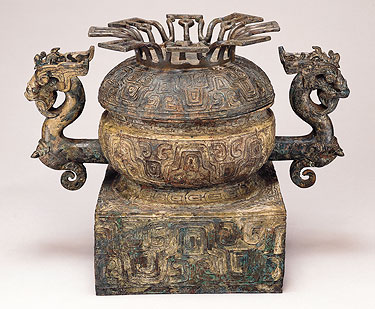
Ritual and Religious Objects
 |
Food Vessel: Gui China, reportedly found in Shandong Province Eastern Zhou period (770-256 BCE), about 6th century BCE Bronze H. 12 3/4 in. (32.4 cm) including cover; W. 15 1/2 in. (39.4 cm) across handles Asia Society, New York: Mr. and Mrs. John D. Rockefeller 3rd Collection, 1979.103a, b |
This vessel, used for serving food during rituals, is known as a gui. It is composed of a round body on a square podium and two flamboyant handles. The main part of the vessel was cast in one piece. The cover, decorated with openwork flanges, was cast separately. The handles are in the form of dragons with tigers crouching on the dragons' necks. Such a complex form would have been created using the lost wax method of casting and would have required multiple ceramic molds. Originally, gui food vessels were simple basins, but as the vessel type gained importance during the early Western Zhou period (ca. 1050-770 BCE), square pedestals were integrated into the form so as to raise it up and thus to enhance its visual impact.